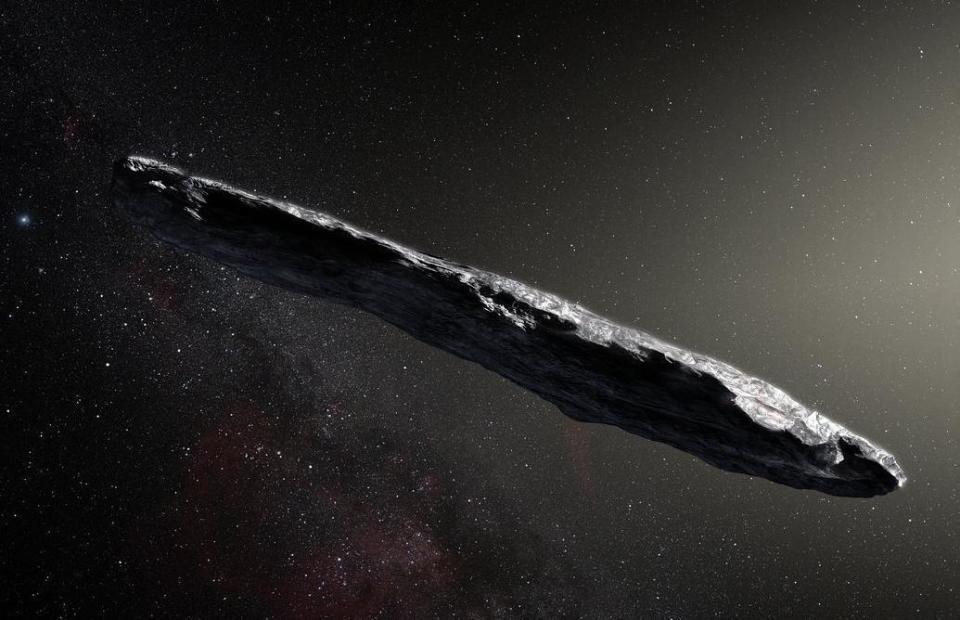Oumuamua: Why scientists are scanning an object flying past Earth for proof of alien technology
Scientists looking for alien life have sparked excitement after announcing they will scan an object flying past Earth to see if it contains alien technology.
If it does, it would rank among the biggest and most unexpected scientific finds ever. And even if it's not an alien craft, there is something very strange about the object.
We should only have to wait for a few days to find out more about the visitor, known as Oumuamua. Here's how we plan to do it, and why.
What's so strange about this object?
Even before suggestions of something more intentional came about, Oumuamua already appeared very strange.
It's far longer and thinner than we'd normally expect – it's hundreds of metres long, but only a tenth as wide. It seems to be travelling on an unusual path, not getting sucked in by our sun's gravity but progressing on a path that will see it fly out of the other side of the solar system.
What's more, it's the first visitor to our solar system that we know to have come from outside. That alone – combined with the other unusual characteristics – make it an unprecedented, unexplained find, whatever it actually turns out to be.
Why might it be an alien spacecraft?
That's the suggestion of Breakthrough Listen, a pioneering and expensive project to find life elsewhere in the universe. The organisation has stressed that it's most likely that it's a natural object – but that it's possible it isn't, and there's no proof either way.
The strangeness of the object has led to suggestions that it would make sense if it was an artifact of an alien civilisation. In particular, its long shape fits in with experts' opinion of the kind of crafts you'd build for long-distance space travel – you get plenty of space, but a relatively low area that will be at risk of being hit by dust or debris as it flies along.
What are they going to do to find out?
In short, listen to it. In very intensive, innovative ways.
Beginning on Wednesday at 8pm UK time, the Green Bank Telescope will be pointed at the object. It will scan it for ten hours, listening in at various radio bands to see if anything is being sent out by it.
Since it's so close by, if anything is coming out then it will almost certainly be heard. If the object has a transmitter as powerful as a cellphone, we'd get something back in less than a minute.
We should know within a few days whether it's been successful, either way.
What if it's not a spacecraft?
It'll still be a useful exercise in testing our best hopes for actually finding aliens, when they come. We'll be using the same techniques that will be used if we meet another potential spacecraft, and show that they'll work in the future.
“‘Oumuamua’s presence within our solar system affords Breakthrough Listen an opportunity to reach unprecedented sensitivities to possible artificial transmitters and demonstrate our ability to track nearby, fast-moving objects,” said Breakthough Listen's Andrew Siemion, director of Berkeley SETI Research Center. “Whether this object turns out to be artificial or natural, it’s a great target for Listen.”
Anything that is discovered during the monitoring will also feed into the general work that scientists around the world are doing on the strange object. Scientists will be listening out for other information about the object, including whether it contains water or ice and what the gaseous envelope that surrounds it might be made of.
What else could it be?
Whatever happened to the object to form it and bring it to this universe was very unusual. But that doesn't necessarily mean it was alien.
Other explanations include the possibility that the rock was a shard of a shredded planet. One SETI scientist had proposed that it was perhaps formed when some large planet got too close to its sun and was ripped to bits – and that since then it has been flying through the universe, until it reached us.

 Yahoo News
Yahoo News 

